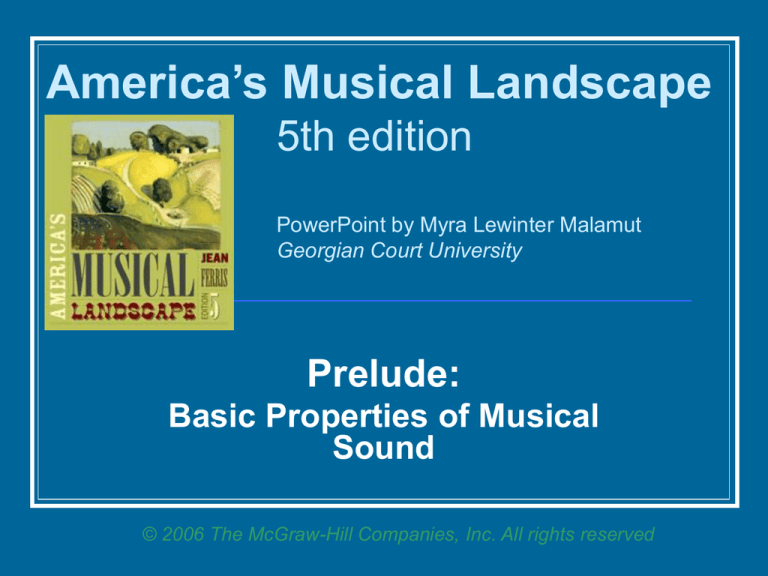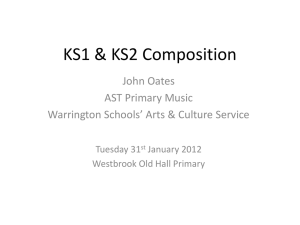
America’s Musical Landscape
5th edition
PowerPoint by Myra Lewinter Malamut
Georgian Court University
Prelude:
Basic Properties of Musical
Sound
© 2006 The McGraw-Hill Companies, Inc. All rights reserved
Prelude:
Basic Properties of Musical Sound
Music, an art of organized sounds, is limitless in variety and in the
power to enchant and challenge our ears
The more we understand the qualities of music, the greater will
be our intellectual, emotional, and aesthetic rewards for listening
to any kind of music
The Elements of Music
Rhythm, melody, harmony, timbre
The fundamental materials of which music is composed
Understanding these elements enhances our listening, provides
vocabulary for discussion, increases our capacity to enjoy music
© 2006 by The McGraw-Hill Companies, Inc.
All rights reserved.
Prelude: Basic Properties of Musical Sound
2
The Elements of Music: Rhythm
Rhythm = The arrangement of time in music
The most basic of the elements of music
Consisting of arrangements of long and short sounds and
silences
Rhythmic values are expressed in the familiar terminology of
fractions (see table 1, page 2)
The specific duration of a musical note depends upon the
tempo = The rate of speed at which music is performed
Tempo and other musical terms are Italian words adopted
into a virtually universal music language in the Western
world
© 2006 by The McGraw-Hill Companies, Inc.
All rights reserved.
Prelude: Basic Properties of Musical Sound
3
Common Tempo Indications
Largo
Adagio
Andante
Moderato
Allegro
Presto
Vivace
Molto
Non troppo
Con brio
© 2006 by The McGraw-Hill Companies, Inc.
All rights reserved.
Slow; “broad”
Slow; “at ease”
Moderately slow; “walking” tempo
Moderate
Fast; cheerful
Very fast
Lively
Very (allegro molto = very fast)
Not too much (allegro non troppo = Not too fast
With spirit
Prelude: Basic Properties of Musical Sound
4
Meter
Similar to language, musical sounds may occur without
specific rhythmic organization
But when musical sounds are arranged in rhythmic patterns
similar to poetry or prose, the music is metered
Meter organizes rhythm into units called measures
Each measure contains a particular number of pulses, or beats
Common meters are
Duple (two beats per measure)
Triple (three beats per measure)
Quadruple (four beats per measure)
The first beat of each measure is normally accented, or stressed
© 2006 by The McGraw-Hill Companies, Inc.
All rights reserved.
Prelude: Basic Properties of Musical Sound
5
The Elements of Music: Melody
Musical sounds, called tones, are caused by something vibrating at
a particular frequency, or rate of speed, and are…
Relatively high or low in pitch = highness or lowness of sound
Tones have letter names, A through G
Interval = The distance between two tones
Octave = The interval of an eighth; the most basic
interval, where two tones share the same letter
name and sound nearly alike
Keys on a keyboard with the same letter name look the
same and have the same position relative to other keys
Melody = A meaningful succession of tones of various pitch levels
© 2006 by The McGraw-Hill Companies, Inc.
All rights reserved.
Prelude: Basic Properties of Musical Sound
6
Melody: Scales
Melodies are based on scales
Scales are stepwise rising or
descending patterns of pitches
within the range of an octave
Keyboard
Major and minor scales are most
prevalent today in Western music;
other scales include
Modes = seven-note patterns
Pentatonic scale = five-note
scale represented by the five
black keys of the keyboard
© 2006 by The McGraw-Hill Companies, Inc.
All rights reserved.
Prelude: Basic Properties of Musical Sound
7
Melody: Further Characteristics
Melodies have rhythm
Tune = A particularly singable and memorable
melody
The tones of a melody occur in some order of long
sounds, short sounds, or both
Such as a children’s song or folk song
Motive = A brief fragmentary melodic idea,
recurring throughout a piece, particularly in
instrumental music
© 2006 by The McGraw-Hill Companies, Inc.
All rights reserved.
Prelude: Basic Properties of Musical Sound
8
The Elements of Music: Harmony
Harmony = The meaningful combination of two or more different
tones
Tonality or the tonal system = The system of harmony that has
governed Western music for about four hundred years
Chord = A meaningful combination of three or more tones
Consonant and dissonant sounds
Consonant sounds seem to be passive or at rest
Dissonant sounds imply tension, drive, or activity
© 2006 by The McGraw-Hill Companies, Inc.
All rights reserved.
Prelude: Basic Properties of Musical Sound
9
Tonal Harmony
The first tone of a major or minor scale, called the
tonic, indicated by the numeral I, represents a
kind of home base
Western music often begins and usually ends on the tonic
The tonic names the key of the composition
Example: If the tonic note is A, and the piece is based upon
a major scale, the key is A major
© 2006 by The McGraw-Hill Companies, Inc.
All rights reserved.
Prelude: Basic Properties of Musical Sound
10
Tonal Harmony:
The Dominant and Subdominant
Triad = The most basic chord in the tonal system, consisting
of three alternate tones
Dominant = The fifth step of the scale, as well as the triad
built upon the fifth scale step; indicated by the numeral V
The dominant wants to go back to the tonic
Subdominant = The fourth step of the scale, as well as the
triad built upon the fourth scale step; indicated by the
numeral IV
The I, IV, and V provide the cornerstones of tonal harmony
© 2006 by The McGraw-Hill Companies, Inc.
All rights reserved.
Prelude: Basic Properties of Musical Sound
11
Texture
Texture = The manner in which melodic lines are used in music—
alone, or combined with other melodic lines or with harmony
Monophonic texture = Music consisting of only one line of
melody
Heterophony = The simultaneous sounding of two or more
versions of the same melody
Polyphonic texture = The simultaneous combination of two or
more melodic lines
Homophonic texture = A melody accompanied by chords
© 2006 by The McGraw-Hill Companies, Inc.
All rights reserved.
Prelude: Basic Properties of Musical Sound
12
Elements of Music: Timbre
Timbre = The characteristic quality of the sound
of a voice or instrument
Timbre = “color”
Musical instruments have distinctive timbres according to
size, material of which they are made, manner in which
they are played, pitch, dynamic level
Dynamic level = Level of volume (loudness or softness) of a
musical sound
© 2006 by The McGraw-Hill Companies, Inc.
All rights reserved.
Prelude: Basic Properties of Musical Sound
13
Dynamic Levels
Levels of Volume
______________________________________________________
Italian term
Abbreviation
English Meaning
______________________________________________________
Pianissimo
Piano
Mezzopiano
Mezzoforte
Forte
Fortissimo
© 2006 by The McGraw-Hill Companies, Inc.
All rights reserved.
pp
p
mp
mf
f
ff
Very soft
Soft
Moderately soft
Moderately loud
Loud
Very loud
Prelude: Basic Properties of Musical Sound
14
Form and Music Notation
Form = the organization or formal design of a musical composition
Form is based upon principles of repetition and contrast
Movement = A section of a complete work that has its own form
and degree of independence, conceived as part of the whole;
usually separated from other movements by a pause
Music notation (see figure 7, page 10)
Staff = The five lines and four spaces on which music is notated
Notes = Written musical pitches and rhythms
Rests = Notated silences in music
Clef = The sign placed at the beginning of the staff, indicating
that a particular line represents a specific pitch
© 2006 by The McGraw-Hill Companies, Inc.
All rights reserved.
Prelude: Basic Properties of Musical Sound
15
Elements of an American Sound
America’s early settlers were culturally
diverse; it took time for music to acquire
a characteristic American sound
Style = A characteristic manner of
composition or performance
American rhythms, often more flexible
than European rhythms, provide
American flavor, including Syncopation,
the delay or anticipation of accented
beats
West Springfield
Painted by
Nelson Augustus Moore (1824-1902
Perhaps you will sense in some American pieces a certain audacity,
a generous expressiveness, a peculiar irregularity, or some other
scarcely definable attribute that simply “sounds American”
© 2006 by The McGraw-Hill Companies, Inc.
All rights reserved.
Prelude: Basic Properties of Musical Sound
16
How to Improve Your Listening Skills
Attendance at live performances, plus repeated and concentrated
study of the textbook’s listening examples are essential to furthering
your understanding and enjoyment of music
Approach each listening experience with expectations of enjoyment
Try to memorize music as you hear it so that it will quickly become
familiar
Apply new knowledge to the music you are hearing
By listening actively, even creatively, you will participate in the
successful collaboration of composer, performer, and listener that
makes possible the magnificent experience of enjoying music
© 2006 by The McGraw-Hill Companies, Inc.
All rights reserved.
Prelude: Basic Properties of Musical Sound
17
Listening Example 1
Chorus:
Love Me tender, love me sweet,
Never let me go.
You have made my life complete
And I love you so.
Love Me Tender
By George R. Poulton (1828-1867)
Lyrics by Elvis Presley
Performed by Marty Robbins
This American song, first popular
with the Union army during the
Civil War with the title “Aura Lee,”
was popularized again, with new
lyrics by Elvis Presley, in 1956.
Accompaniment: Guitar
Listening guide page 12
Meter: Quadruple (four beats per measure)
Tempo: Slow, relaxed
Form: Strophic, with verse-chorus structure; a refrain = chorus
Each time you listen to this song, try to hear something that escaped
your notice before, “stretching your ears” to capture everything!
© 2006 by The McGraw-Hill Companies, Inc.
All rights reserved.
Prelude: Basic Properties of Musical Sound
18
Image Credit
Slide 16: West Springfield, painted by
Nelson Augustus Moore
Photo © Corel
© 2006 by The McGraw-Hill Companies, Inc.
All rights reserved.
Prelude: Basic Properties of Musical Sound
19








